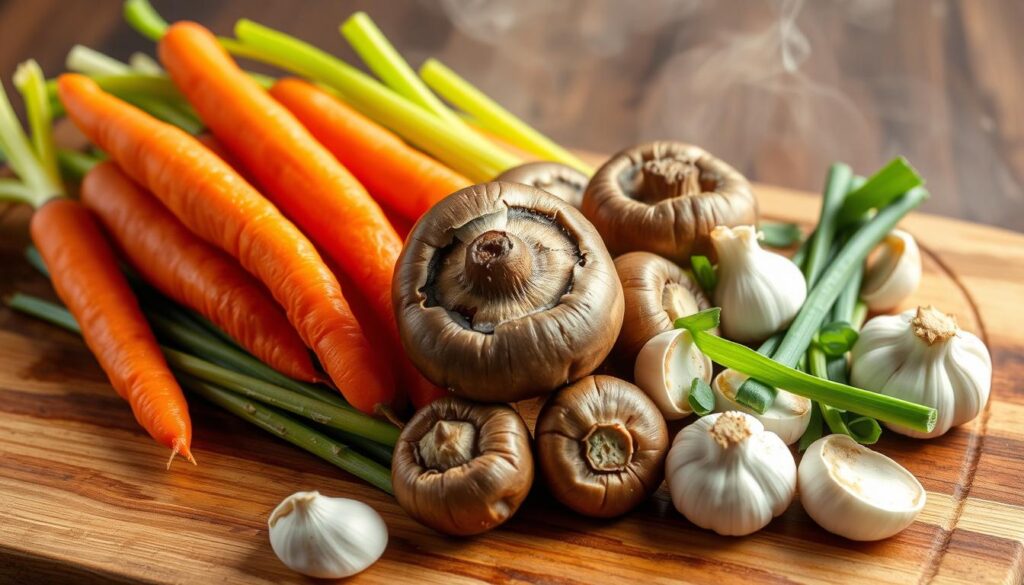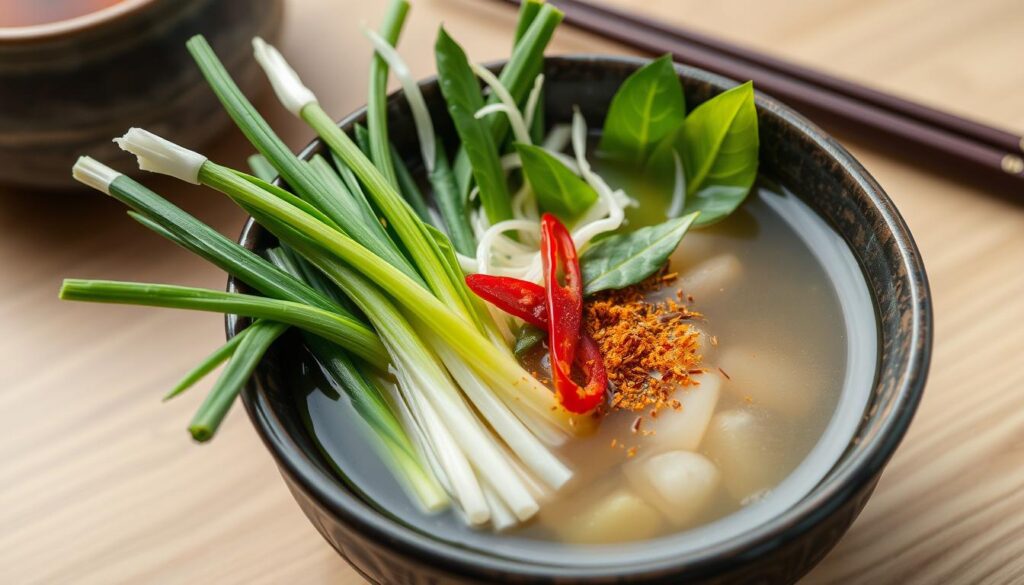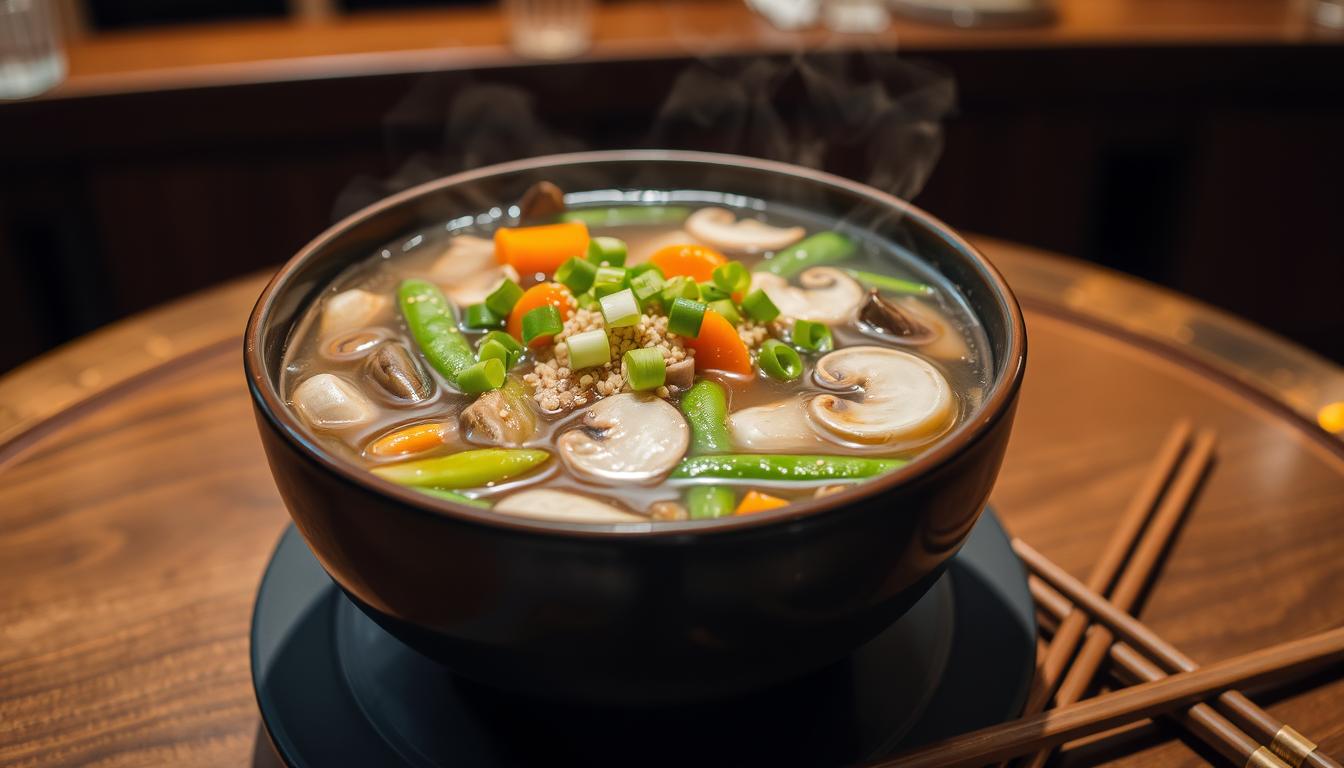When winter winds blow, nothing warms us like a hot bowl of Japanese clear soup. I remember my family’s trips to the Hibachi restaurant every month. The chef would make this soup right in front of us, filling the air with amazing smells.
The colors of the vegetables and the taste of the soup were unforgettable. It was more than just food; it was an experience that I’ve always loved.
If you love Hibachi or want to try real Japanese food, you must try this hibachi soup. It’s also known as Japanese clear soup or Miyabi soup. It’s made with chicken broth and beef broth, making it a light and healthy start to your meal.
Key Takeaways
- Hibachi soup, or Japanese Clear Soup, is a traditional appetizer served at Hibachi restaurants.
- It’s made with a combination of chicken and beef broth, water, and fresh vegetables like onions, carrots, and celery.
- The soup is simmered for at least an hour to develop a rich, flavorful broth, then strained to achieve a clear, elegant consistency.
- Garnished with thinly sliced mushrooms and scallions, this soup is both comforting and flavorful.
- With its low-calorie and low-carb profile, Hibachi soup makes for a healthy and satisfying starter before a larger meal.
Understanding Japanese Clear Soup Traditions
Japan’s rich culinary heritage shines through its many soups. Each soup has its own unique taste and cultural importance. From the warm miso soup to the light clear soup, they are loved by all who enjoy Japanese food.
Origins of Hibachi Restaurant Soups
The history of hibachi restaurant soups goes back to the 16th century. Portuguese traders brought new soup styles to Japan then. This led to the creation of suimono, a clear soup that’s now a big part of Japanese food.
Cultural Significance in Japanese Cuisine
In Japan, soups are more than just food. They show the country’s love for simple yet deep flavors. Soups like miso, zosui, and egg drop soup are key parts of Japanese meals. They warm up the taste buds before the main dish.
Different Regional Variations
- Miso soup is a big part of Japanese food, enjoyed at all meals.
- Clear soups, like suimono, vary by region. Some use chicken broth, while others use beef or mushroom for a richer taste.
- Soba noodle soup, with buckwheat soba noodles, is loved hot or cold, depending on the season.
- Creamy corn soup and hearty udon noodle soup are just a few of the many regional soup specialties in Japan.
Soups in Japan are a big part of the Japanese cuisine experience. They are enjoyed before the main meal or on their own. Each sip combines tradition, flavor, and cultural importance.
“Soup is a lot like a family. Each ingredient enhances the others; each batch has its own unique character; and it needs time to develop its complex flavor.”
Essential Ingredients for Authentic Hibachi Soup
Making an authentic Japanese hibachi soup starts with the right ingredients. This clear soup is a favorite in hibachi restaurants. It combines flavors and textures that bring Japan’s culinary traditions to life.
The soup’s base is a flavorful broth. It’s made by mixing chicken broth and beef broth in a 2:1 ratio. Chicken broth adds a light touch, while beef broth gives it a richer taste.
Fresh vegetables and aromatic ingredients are key to the soup’s taste and texture. These include:
- Sweet onion, diced
- Garlic, minced
- Carrots, julienned
- Ginger, finely grated
- Scallions, sliced
- Button mushrooms, sliced
A bit of sesame oil adds a nutty flavor to the broth. Scallions and mushrooms make the soup look and feel great.
| Ingredient | Quantity |
|---|---|
| Chicken broth | 4 cups |
| Beef broth | 2 cups |
| Water | 2 cups |
| Sweet onion, diced | 1 medium |
| Garlic, minced | 3 cloves |
| Carrots, julienned | 2 medium |
| Ginger, finely grated | 1 tablespoon |
| Scallions, sliced | 4 |
| Button mushrooms, sliced | 1 cup |
| Sesame oil | 1 tablespoon |
With these hibachi soup ingredients and the right techniques, you can make a traditional and tasty Japanese soup recipe. It will amaze your taste buds and take you to Japan’s vibrant flavors.
The Perfect Broth Base Combination
Making the perfect Hibachi soup begins with a balanced broth. You need a mix of chicken and beef broths. This mix gives a rich, meaty taste that’s the heart of the Japanese broth.
Choosing the Right Chicken and Beef Broth Ratio
The mix of chicken to beef broth is key for taste and texture. Chicken broth adds a light touch, while beef broth brings a deeper flavor. Together, they make a clear soup broth that’s both light and full of taste.
Importance of Water Balance
Getting the water balance right is vital for a clear soup broth. Too much water makes it taste weak, too little makes it too strong. Finding the perfect balance makes your Japanese broth both tasty and beautiful.
Role of Sesame Oil in Flavor Development
Sesame oil is important for the soup’s flavor. It adds a nutty taste that blends well with other ingredients. This oil helps make the clear soup broth more flavorful and satisfying.
Core Vegetables and Aromatics Selection
The heart of a great vegetable soup or mushroom soup is choosing the right ingredients. For Hibachi soup, key vegetables and aromatics add depth and complexity. They include:
- Onions: Diced onions add a savory, caramelized sweetness to the soup.
- Carrots: Sliced carrots contribute a subtle sweetness and vibrant color.
- Celery: Chopped celery stalks provide a refreshing, aromatic element.
- Garlic: Minced garlic cloves infuse the broth with a pungent, earthy flavor.
- Ginger: Freshly grated ginger lends a warm, slightly spicy note to the soup.
These ingredients are roughly chopped and simmered in the broth. This process allows their flavors to blend and enrich the liquid. After simmering, they are strained out. This leaves a clear, flavorful soup base.
The garnish vegetables, like thinly sliced button mushrooms and scallions, are added fresh. They add texture and color to the final dish.

“The secret to a truly exceptional Hibachi soup lies in the thoughtful selection and preparation of the vegetable and aromatic components. Each ingredient plays a vital role in crafting the perfect balance of flavors.”
Step-by-Step Cooking Process
Learning to make how to make hibachi soup starts with a detailed cooking process. This Japanese soup recipe needs careful steps to get the clear broth and rich taste right.
Proper Vegetable Caramelization Techniques
Start by cooking onions in sesame oil over medium heat for 10 minutes. This makes them sweet and golden. Then, add carrots, celery, and garlic. Cook for 2-3 more minutes until they’re soft but still a bit crunchy.
Simmering and Straining Methods
Next, add chicken broth and water, then boil. Turn down the heat and allow it to simmer for 30 minutes to 1 hour. This blends the flavors. Strain the soup to get rid of solids, making it clear.
Achieving the Perfect Clear Consistency
Getting a clear soup is all about straining. Remove solids to keep the broth smooth and clear. Don’t over-boil, as it can make the soup cloudy.
| Ingredient | Amount |
|---|---|
| Onion, diced | ½ large |
| Carrot, diced | ¼ cup |
| Celery, diced | ¼ cup |
| Garlic, minced | 1 clove |
| Chicken broth | 4 cups |
| Water | 2 cups |
| Salt | ½ teaspoon |
| Fried onions | 1 cup |
| Mushrooms, sliced | ½ cup |
| Green onions, sliced | 2 stalks |
This how to make hibachi soup recipe makes 6 servings. It’s easy to prepare, taking only 30 minutes. Each serving has 79 calories, 7g carbs, 2g protein, and 5g fat, making it healthy and filling.
“The key to a truly exceptional Japanese soup recipe is in the details – from caramelizing the vegetables to the precise straining process. This ensures a clear, flavorful broth that showcases the authentic taste of Japan.”
Mastering the Art of Garnishing
Enjoying a delicious Japanese clear soup is all about the garnish. The right toppings can make a big difference. Traditional favorites like scallions and mushrooms are top choices.
Getting the garnishes right is all about precision. Slice them very thin so they float on the broth. To keep them fresh, add them just before serving.
But there are many other clear soup toppings to try. You can use:
- Aromatic herbs like parsley and cilantro
- Crunchy fried shallots or garlic for a savory crunch
- A splash of toasted sesame oil adds a nutty fragrance
- A pinch of crushed red pepper flakes adds a subtle heat
These garnishes let you make your Japanese soup your own. So, next time, add some flair to your clear soup.
| Ingredient | Quantity |
|---|---|
| Clear Broth | 4 cups |
| Fresh Mushrooms | 8 oz, sliced |
| Onion | 1, diced |
| Garlic | 3 cloves, minced |
| Soy Sauce | 2 tablespoons |
| Salt and Pepper | To taste |
| Fresh Herbs (optional) | As desired |

The broth’s flavor is key. Roast the bones for 45-60 minutes and then simmer for 4-6 hours. This makes the broth rich and balanced.
“The beauty of Japanese soup garnish lies in its ability to transform a simple dish into a culinary masterpiece, elevating the overall experience with each delightful bite.”
Health Benefits and Nutritional Value
Hibachi soup is a traditional Japanese dish that’s good for you. It has only 70-100 calories per serving. This makes it perfect for those watching their weight or eating healthy.
The soup is low in fat (2-4g) and carbs (12-15g), and has a bit of protein (2-4g). It fits well into many diets, like low-carb, keto, paleo, and Whole30. Ginger and garlic in the soup may help fight inflammation, making it great for when you’re not feeling well.
Caloric Content and Dietary Considerations
Hibachi soup is a low-calorie soup with 70-100 calories per serving. It’s great for keeping a balanced diet or controlling weight.
Therapeutic Properties of Ingredients
Ginger and garlic in hibachi soup have health benefits. Ginger can reduce inflammation, helping your body feel better. Garlic supports your immune system and heart health.
Together, these ingredients make hibachi soup a healthy choice for those who care about their well-being.
“Eating healthy soup like hibachi can help your overall health and support a balanced lifestyle.”
Serving Suggestions and Pairings
Hibachi soup is a great starter that goes well with many Japanese dishes. It’s a perfect match for grilled steak, chicken, or shrimp. Serving it with steamed rice or a green salad makes for a light meal.
Adding soy sauce or sriracha can enhance the soup’s taste. These toppings add a bit of spice without overpowering the broth. Pairing it with sake or Japanese beers like Sapporo or Asahi is also a good idea.
For a full Japanese meal, add sides like miso soup, fried rice, or tempura. Finish with desserts like mochi ice cream or green tea cake. These sweet treats balance out the savory flavors of the hibachi meal.

